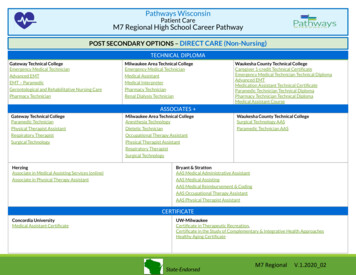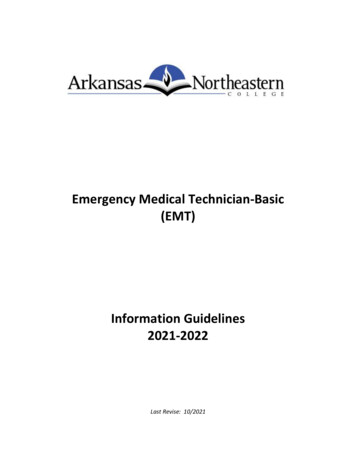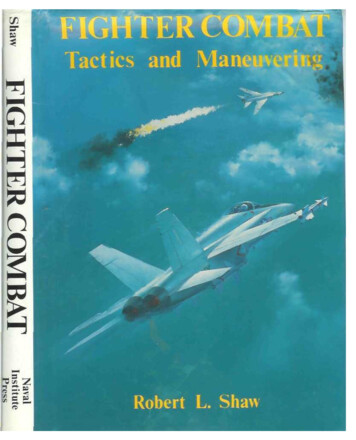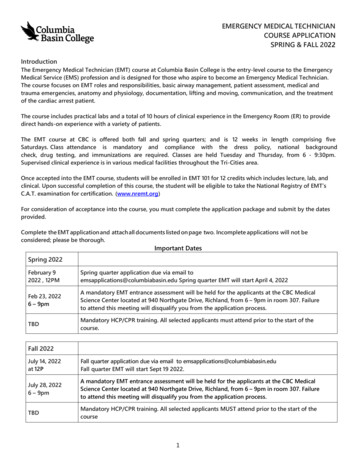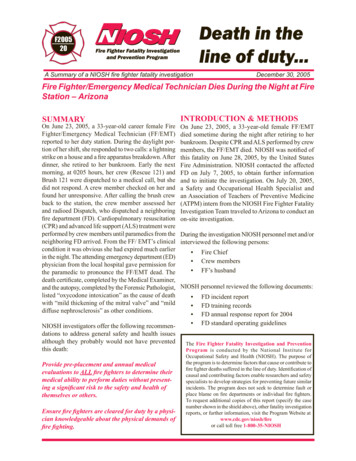
Transcription
F200520A Summary of a NIOSH fire fighter fatality investigationDecember 30, 2005Fire Fighter/Emergency Medical Technician Dies During the Night at FireStation – ArizonaSUMMARYINTRODUCTION & METHODSOn June 23, 2005, a 33-year-old career female FireFighter/Emergency Medical Technician (FF/EMT)reported to her duty station. During the daylight portion of her shift, she responded to two calls: a lightningstrike on a house and a fire apparatus breakdown. Afterdinner, she retired to her bunkroom. Early the nextmorning, at 0205 hours, her crew (Rescue 121) andBrush 121 were dispatched to a medical call, but shedid not respond. A crew member checked on her andfound her unresponsive. After calling the brush crewback to the station, the crew member assessed herand radioed Dispatch, who dispatched a neighboringfire department (FD). Cardiopulmonary resuscitation(CPR) and advanced life support (ALS) treatment wereperformed by crew members until paramedics from theneighboring FD arrived. From the FF/ EMT’s clinicalcondition it was obvious she had expired much earlierin the night. The attending emergency department (ED)physician from the local hospital gave permission forthe paramedic to pronounce the FF/EMT dead. Thedeath certificate, completed by the Medical Examiner,and the autopsy, completed by the Forensic Pathologist,listed “oxycodone intoxication” as the cause of deathwith “mild thickening of the mitral valve” and “milddiffuse nephrosclerosis” as other conditions.On June 23, 2005, a 33-year-old female FF/EMTdied sometime during the night after retiring to herbunkroom. Despite CPR and ALS performed by crewmembers, the FF/EMT died. NIOSH was notified ofthis fatality on June 28, 2005, by the United StatesFire Administration. NIOSH contacted the affectedFD on July 7, 2005, to obtain further informationand to initiate the investigation. On July 20, 2005,a Safety and Occupational Health Specialist andan Association of Teachers of Preventive Medicine(ATPM) intern from the NIOSH Fire Fighter FatalityInvestigation Team traveled to Arizona to conduct anon-site investigation.NIOSH investigators offer the following recommendations to address general safety and health issuesalthough they probably would not have preventedthis death:Provide pre-placement and annual medicalevaluations to ALL fire fighters to determine theirmedical ability to perform duties without presenting a significant risk to the safety and health ofthemselves or others.Ensure fire fighters are cleared for duty by a physician knowledgeable about the physical demands offire fighting.During the investigation NIOSH personnel met and/orinterviewed the following persons: Fire ChiefCrew membersFF’s husbandNIOSH personnel reviewed the following documents: FD incident reportFD training recordsFD annual response report for 2004FD standard operating guidelinesThe Fire Fighter Fatality Investigation and PreventionProgram is conducted by the National Institute forOccupational Safety and Health (NIOSH). The purpose ofthe program is to determine factors that cause or contribute tofire fighter deaths suffered in the line of duty. Identification ofcausal and contributing factors enable researchers and safetyspecialists to develop strategies for preventing future similarincidents. The program does not seek to determine fault orplace blame on fire departments or individual fire fighters.To request additional copies of this report (specify the casenumber shown in the shield above), other fatality investigationreports, or further information, visit the Program Website atwww.cdc.gov/niosh/fireor call toll free 1-800-35-NIOSH
Fatality Assessment and Control EvaluationInvestigative Report #F2005-202005Fire Fighter/Emergency Medical Technician Dies During the Night at Fire Station – Arizona Ambulance reportDeath certificateAutopsy reportPrimary care physician recordsINVESTIGATIVE RESULTSthis, she commented that the new vitamins she wastaking were making her itch.At about 1700 hours, there was a departmental meeting to discuss backfill coverage during wildland fireassignments. During this meeting, the FF/EMT spokewith several FD personnel and was not exhibitingsymptoms other than her eyes appearing irritated.Again, she commented that the new vitamins werecausing the problem. At about 1830 hours, the FF/EMT ate dinner and went upstairs to her bunkroom.Passing a crew member in the hallway, the FF/EMTcommented that she was tired and going to bed. Theshift Captain went to her room to advise her about ameeting the next morning and subsequently inquiredabout her rash; she stated that it seemed to be goingaway. At about 1930 hours, the FF/EMT’s husbandarrived at the station to visit her. At about 1945 hours,her daughter called and spoke with the FF/EMT onthe telephone. Her husband left the station at about2020 hours. Both the daughter and husband reportedthat the FF/EMT showed no signs and expressed noconcerns about health problems.On June 23, 2005, the FF/EMT arrived at her fire station at 0600 hours. She was scheduled for an annualFD medical evaluation that morning. She left the station, drove to the clinic, and completed the physicalevaluation. She had a normal resting electrocardiogram(EKG) and performed an exercise stress test (EST),exercising for 10 minutes, 53 seconds using the Bruceprotocol,1 achieving a work level of 13.5 metabolicequivalents (METS) and a maximum heart rate of 134beats per minute (72% of the maximal age-predictedheart rate). Her resting blood pressure was 97/69 millimeters of mercury (mmHg); it rose to 128/74 mmHgduring exercise. Her heart rate and blood pressureresponses to exertion were appropriate. No chest painand no ischemic changes were found on the EKG; noarrhythmias were identified; and the EST was deemednegative. A drug screen was also negative, and the On June 24, 2005, at 0205 hours, the FD was disFF/EMT was cleared for duty.patched to a medical call. As Brush 121 began torespond, a crew member asked the Captain if theShe returned to her station at 1000 hours. The FD FF/EMT was a heavy sleeper. The Captain said “yes”was participating in “Safety Stand Down Day” and and sent him upstairs to awaken her while Brush 121this FF/EMT participated in discussions of various continued to respond.safety topics including physical fitness. At 1225hours, the FD was dispatched to a residence that had The crew member knocked on the bunkroom doorbeen struck by lightning. The FF/EMT donned her several times. Not getting a response, he then enteredbunker gear and responded on the engine. Arriving the room and found the FF/EMT lying on the bed, faceon scene, it was determined to be a false alarm. At down with her head and right arm hanging off the bed.about 1300 hours, the crew returned to the station and She did not respond to verbal or painful stimuli. Thethe FF/EMT’s husband brought her dinner. At 1630 crew member placed her on her back, opened her airhours, Rescue 121 was dispatched with other FD units way and checked for a pulse. Finding no pulse, he ranto assist with a FD engine that had broken down at to the Rescue unit and obtained medical equipment.an intersection. The FF/EMT, riding R121, assisted He placed an oropharyngeal airway and attached awith directing traffic while the engine was removed cardiac monitor to her. The monitor revealed asystolefrom the intersection, and she assisted with removing (no heart beat) and he began rescue breathing withequipment and loading it onto Brush Truck 121. Dur- a bag-valve-mask. The crew member notified Brushing this time, crew members noticed the FF/EMT’s 121 of the situation via radio at about 0209 hours andneck was red. When crew members informed her of Brush 121 returned to the station.Page 2
Fatality Assessment and Control EvaluationInvestigative Report #F2005-202005Fire Fighter/Emergency Medical Technician Dies During the Night at Fire Station – ArizonaUpon Brush 121’s arrival at the station, resuscitationefforts including CPR had already been initiated by thecrew member. The Captain notified Dispatch at about0211 hours and requested an ambulance from a neighboring FD. During the resuscitation, emesis developed in thebag-valve-mask, and suctioning was performed. An intravenous line was placed and the incident was reportedto the local hospital ED. From the FF/EMT’s clinicalcondition it was obvious she had expired much earlierin the night. After receiving the patient report from theparamedic, the attending ED physician gave permissionfor the paramedic to pronounce the FF/EMT dead at0232 hours, and resuscitation efforts were stopped. Thesheriff’s office and coroner were then notified.Medical Findings. The death certificate, completedby the Medical Examiner, and the autopsy, performedby the Forensic Pathologist on June 25, 2005, includedthe following findings: Oxycodone intoxication (blood level of 0.85milligrams per liter [mg/L])(therapeuticblood levels are less than 0.1 mg/L)2 Mild thickening of the mitral valveMicroscopic examination of the heart revealed scattered foci of interstitial fibrosis.Primary care physician (PCP) medical evaluationsfrom 2000 revealed two coronary artery disease(CAD) risk factors: family history of CAD and hyperlipidemia successfully treated with a low cholesterol/low fat diet and an exercise program.tests were essentially normal, and a detaileddescription of the episodes effectively ruledout the possibility of seizures.2) Possible hypoglycemic disorders. Work-upincluded several specialized blood tests(insulin, c-peptide, beta hydroxybutyrate,cortrosyn stimulation) and an endocrinologyconsultation. These tests were all normal andher unusual symptoms were not felt to berelated to a hypoglycemic condition.3) Possible arrhythmia or heart problem. Workup included blood tests, a Holter monitor,resting electrocardiogram (EKG), and anexercise stress test done as part of her FDmedical evaluation. These were all normal.4) Possible psychiatric condition. Work-up included a consultation with a psychiatrist whodiagnosed probable post-traumatic stress disorder due to an assault during her teens. Thediagnosis of a mood disorder (not otherwisespecified) or a mild bipolar disorder was alsoconsidered. She had been prescribed two antidepressants and a diuretic by her PCP priorto this episode.According to the FF/EMT’s husband, who had spoken to her about six times throughout the day andwas the last person to see her prior to her death, shedid not express any symptoms of cardiac-relatedproblems. She did not seem depressed or mentionsuicidal thoughts. Her only complaint was that shewas tired. He was unaware that she was taking anew vitamin.During 2004 the FF/EMT reported 10-12 episodesof erratic behavior, mood swings, and paranoia. Herlocal primary care provider referred her to a tertiarycare medical center for an extensive medical evalua- DESCRIPTION OF THE FIREtion. Over a 2-3 month period she was evaluated for DEPARTMENTAt the time of the NIOSH investigation, this combinathe following conditions:tion FD consisted of 35 uniformed personnel, served1) Possible seizure disorder. Work-up included a year-round population of 15,000 in a 25 square milea magnetic resonance imaging (MRI), blood area, and had two fire stations.tests, and a neurology consultation. ThesePage 3
2005Fatality Assessment and Control EvaluationInvestigative Report #F2005-20Fire Fighter/Emergency Medical Technician Dies During the Night at Fire Station – ArizonaIn 2004, the FD responded to 3,163 calls: 197 fires, 4. 4th Quarter: Modified Work Capacity Test Per166 accidents, six technical rope rescues, 158 falsesonnel will wear a 25-pound pack and walk 3alarms, 766 community relations calls, 530 citizenmiles within 46 minutesassist calls, and 1,340 emergency medical calls.State fire fighter certification is voluntary for all fireMembership, Employment, and Training. The fighters (FFI and FFII). There is no annual recertiFD requires all “redshirt” volunteer fire fighter fication requirement. The FF was certified as a Fireapplicants to complete an application, be at least Fighter II, Emergency Medical Technician, and in18 years of age, possess a high school diploma or Ropes I, II, and III. She had 2 years of fire fightingequivalent, possess a valid state driver’s license, experience.pass a physical examination, and have the abilityand willingness to train in fire fighting and related Pre-placement Physical Examination. A pre-placement physical examination is required by this FD foractivities.all career applicants. The contents of the examinationTo become employed as a “reserve fire fighter,” for full-time applicants are as follows:the FD attempts to hire from qualified “redshirts.” Complete medical historyQualifications and testing for reserves follow the Physical examinationsame guidelines as full-time personnel, which Vital signsincludes certifications as Fire Fighter II (FFII) or Blood testing: complete blood count andEmergency Medical Technician. The applicant mayblood lipidsachieve the certification within one year of hire at Urinalysisthe discretion of the Fire Chief. The applicant mustpass a written exam, a physical examination, and a Urine drug screenphysical agility test (PAT) prior to being hired. Full Spirometrytime fire fighters are hired from in-house reserve fire Resting EKGfighters if possible. Full-time fire fighters work 24 ESThours on-duty, 0800 hours to 0800 hours, and are Baseline chest x-rayoff-duty for 48 hours. Audiogram Vision testPhysical Fitness Testing. All fire suppression personnel are required to pass the following physicalVolunteer applicants receive the Department of Transfitness tests:portation (DOT) medical examination for commercialst1. 1 Quarter: Wildland Physical Fitness Test (Work driver’s license (CDL), which does not include bloodCapacity Test [Pack Test]) Personnel will wear tests, spirometry, chest x-ray, or EST.a 45-pound pack and walk 3 miles within 46A District-contracted physician performs the mediminutescal examinations and forwards the clearance fornd2. 2 Quarter: Modified Work Capacity Test Per- duty decision to the Fire Chief, who makes the finalsonnel will wear a 25-pound pack and walk 3 determination regarding clearance for duty.miles within 46 minutesPeriodic Evaluations. Annual medical evaluations3. 3 Quarter: Physical Ability Test The PAT are required for all members. The evaluation for fullwill consist of tasks geared to the daily job time members is more stringent than the evaluationfor volunteers. The components are the same as thefunctionsrdPage 4
2005Fatality Assessment and Control EvaluationInvestigative Report #F2005-20Fire Fighter/Emergency Medical Technician Dies During the Night at Fire Station – Arizonapre-placement medical evaluation except a chest xray is not required unless clinically indicated. Again,volunteer members receive the CDL medical evaluation. Annual SCBA clearance is required. A Districtcontracted physician performs the medical evaluationsand forwards the clearance for duty decision to the FireChief, who makes the final determination regardingclearance for duty.Oxycodone is capable of producing stupor, coma,muscle flaccidity, severe respiratory depression, hypotension, and cardiac arrest in overdosage. Little isknown about the postmortem toxicology or pathologyof oxycodone-related deaths. In a series of 24 deathsattributed solely to oxycodone, postmortem bloodconcentrations averaged 1.2 mg/L (range 0.1-8.0).3While this FF/EMT’s oxycodone blood concentration was below this average, it was still within theAn annual PAT and the US Forest Service pack test fatal range.for Wildland Red Card certification are required forcareer and reserve members. There is a mandatory This FF/EMT had a blood test at 0645 hours on thefitness program. A return-to-duty medical clearance day of this incident as part of the FD annual medicalis required from the fire fighter’s PCP for duty-re- evaluation. This blood test was negative for opiateslated injuries. A return-to-duty medical clearance is (narcotics). Her blood level of oxycodone at autopsyrequired from the fire fighter’s PCP for illnesses that was 0.85 mg/L. Witnesses who spoke to her at theprevent fire fighters from performing their duty for meeting at 1700 hours stated that she exhibited nothree shifts. The clearance is provided to the FD, who symptoms of having taken medication except forreviews it and makes a final determination regarding irritated eyes. Witnesses who saw her around dinnertime stated she admitted to being very tired and wasreturn to work.going to bed. Her husband, the last person to see theFF/EMT, stated she had no symptoms other thanbeing tired. According to medical records availableDISCUSSIONOxycodone (Oxycontin) is a narcotic analgesic avail- to NIOSH investigators, the FF/EMT was never preable in oral formulations often in combination with scribed oxycodone. It is unclear how she obtained theother drugs such as acetaminophen, aspirin, phenac- medication or why it was taken. The County Sheriff’setin, and caffeine.3 It is frequently used to treat pain, Office determined the death to be accidental.typically due to cancer or severe musculoskeletalinjuries.2 The usual adult dose is 2.5 - 5.0 mg every 6hours, although patients with moderately severe painmay take 10 - 30 mg every 4 hours. The drug is alsoavailable in prolonged-release tablets containing 10 80 mg given every 12 hours. Therapeutic blood levelsare less than 0.1 mg/L.2 The FF/EMT had a blood levelover 8 times the therapeutic maximum.On autopsy, the FF/EMT was found to have mitralvalve thickening and some cardiac muscle interstitialfibrosis. It is unlikely either of these findings wererelated to her sudden death.According to crew members, the FF/EMT related shewas taking a new vitamin and it was causing a rash.The NIOSH investigator was unable to obtain anyIn human subject testing, plasma oxycodone con- information about this vitamin and it was not detectedcentrations peak somewhere between 0.8-2.5 hours on the drug screen during her FD medical evaluationpost-dose.3 In subjects receiving an unusually large that morning nor by the autopsy.dose (20 mg in a 154-pound person), peak plasmaconcentrations averaged 0.038 mg/L at an average Occupational Medical Standards for Structuraltime of 1 hour.3 Subjects receiving single 40 or 80 mg Fire Fighters. To reduce the risk of sudden cardiaccontrolled-release tablets attained average maximal arrest or other incapacitating medical conditionsamong fire fighters, the National Fire Protection Asplasma levels of 0.039 and 0.099 mg/L.3Page 5
2005Fatality Assessment and Control EvaluationInvestigative Report #F2005-20Fire Fighter/Emergency Medical Technician Dies During the Night at Fire Station – Arizonasociation (NFPA) developed NFPA 1582, Standardon Comprehensive Occupational Medical Programfor Fire Departments.4 NFPA 1582 lists narcoticuse as a Category A medical condition for candidates and a condition that potentially interfereswith fire fighting duties for members.4 Had the FDor the FD physician known of its use, she probablywould not have been cleared for unrestricted firefighting duties.the personal and economic costs of dealing with themedical evaluation results. NFPA 1500, Standard onFire Department Occupational Safety and HealthProgram, Chapters 8-7.1 and 8-7.27and the NVFCHealth and Wellness Guide6 address these issues.We recommend the FD expand the medical evaluationprogram to include volunteers. The physical evaluation could be conducted by the fire fighter’s primarycare physician or a District-contracted physician.If the evaluation is performed by the fire fighter’sRECOMMENDATIONSprimary care physician, the results must be commuNIOSH investigators offer the following recommennicated to the District physician, who makes the finaldations to address general safety and health issuesdetermination for clearance for duty.although they probably would not have preventedthis death:Recommendation #2: Ensure fire fighters arecleared for duty by a physician knowledgeable aboutRecommendation #1: Provide pre-placement andthe physical demands of fire fighting.annual medical evaluations to ALL fire fighters todetermine their medical ability to perform dutiesPhysicians who provide input regarding medicalwithout presenting a significant risk to the safetyclearance for fire fighting duties should be knowland health of themselves or others.edgeable about the physical demands of fire fightingand that fire fighters frequently respond to incidentsThe FD requires a comprehensive pre-placementin environments that are immediately dangerous toand periodic physical examination for career aplife and health. They should also be familiar with aplicants and members and is commended for doingFF’s personal protective equipment and the consensusso. Volunteer applicants and members receive theguidelines published by NFPA 1582, Standard onDOT CDL physical examination, which is lessComprehensive Occupational Medicine Program forstringent.Fire Departments.4 Primary care physicians providereturn to work clearances for this FD. To ensure physiGuidance regarding the content and frequency ofcians are aware of these guidelines, we recommendpre-placement and periodic medical evaluations andthat the FD, or the FF, provide the personal physiciansexaminations for structural fire fighters can be foundwith a copy of NFPA 1582.in NFPA 1582, Standard on Comprehensive Occupational Medical Program for Fire Departments,4We also recommend the District physician review allin the report of the International Association of Firemedical clearances, and not necessarily accept theFighters/International Association of Fire Chiefsopinions of specialists or other treating physicians(IAFF/IAFC) Wellness/Fitness Initiative,5 and theregarding return to work. This decision requiresNational Volunteer Fire Council (NVFC) Healthknowledge not only of the medical condition, but alsoand Wellness Guide.6 However, the FD is not legallyof the fire fighter’s job duties. Personal physicians mayrequired to follow any of these standards.not be familiar with an employee’s job duties, or withguidance documents such as NFPA 1582. In addition,Applying NFPA 1582 involves economic issues.they may consider themselves patient advocates andThese economic concerns go beyond the costs ofdismiss the potential public health impact of publicadministering the medical program; they involvesafety officials who may be suddenly incapacitated.Page 6
2005Fatality Assessment and Control EvaluationInvestigative Report #F2005-20Fire Fighter/Emergency Medical Technician Dies During the Night at Fire Station – ArizonaTherefore, we recommend that a “FD physician” whohas the final decision regarding medical clearancereview all return-to-work clearances.7. NFPA [2002]. Standard on fire department occupational safety and health program. QuincyMA: National Fire Protection Association.NFPA 1500.REFERENCES1. WorldAR [2002]. Bruce treadmill protocol.World Wide Web (Accessed March 2004).Available from ATOR INFORMATION2. Karch SB [2002]. Karch’s pathology of drugabuse. Boca Raton, FL: CRC Press. 3rd Edition.pp. 372-373.Tommy N. Baldwin, MSSafety and Occupational Health Specialist3. Baselt RC [2004]. Disposition of toxic drugs andchemicals in man. Foster City, CA: BiomedicalPublications. 7th Edition. pp. 829-831.Meghan ButasekFire Fighter, Association of Teachers ofPreventive Medicine (ATPM) Intern4. NFPA [2003]. Standard on comprehensive occupational medical program for fire departments.Quincy MA: National Fire Protection Association. NFPA 1582.5. IAFF, IAFC. [2000]. The fire service jointlabor management wellness/fitness initiative.Washington, D.C.: International Association ofFire Fighters, International Association of FireChiefs.This investigation was conducted by and the reportwritten by:Mr. Baldwin, a National Association of Fire Investigators (NAFI) Certified Fire and Explosion Investigator, an International Fire Service AccreditationCongress (IFSAC) Certified Fire Officer I, and aKentucky Certified Fire Fighter and EmergencyMedical Technician (EMT), is with the NIOSH FireFighter Fatality Investigation and Prevention Program, Cardiovascular Disease Component located inCincinnati, Ohio. Ms. Butasek is a fire fighter withthe Charlottesville, Virginia Fire Department andan ATPM intern assigned to NIOSH for a 3-monthrotation.6. NVFC and USFA [2004]. Health and wellnessguide for the volunteer fire service, Emmitsburg,MD: Federal Emergency Management Agency;USFA, Publication No. FA-267/January 2004.Page 7
U. S. Department of Health and Human ServicesPublic Health ServiceCenters for Disease Control and PreventionNational Institute for Occupational Safety and Health4676 Columbia Parkway, MS C-13Cincinnati, OH 45226-1998OFFICIAL BUSINESSPenalty for private use 300Delivering on the Nation’s promise:Safety and health at work for all peoplethrough research and prevention
166 accidents, six technical rope rescues, 158 false alarms, 766 community relations calls, 530 citizen assist calls, and 1,340 emergency medical calls. Membership, Employment, and Training. The Fire Fighter/Emergency Medical Technician Dies During the Night at Fire Station - Arizona


